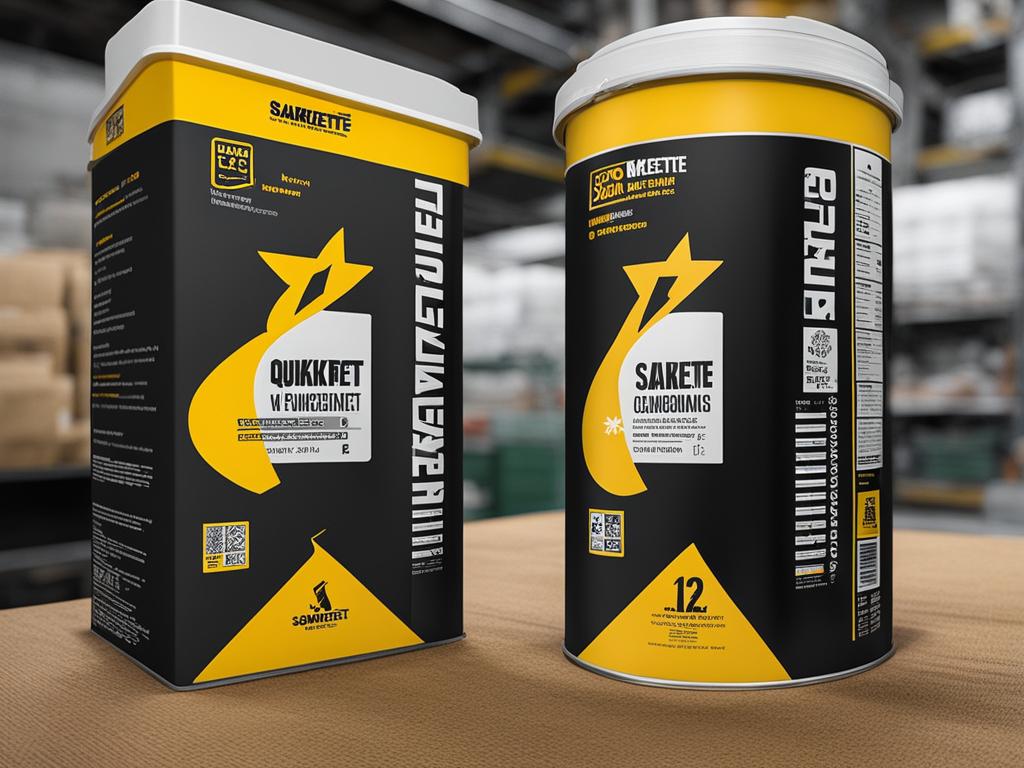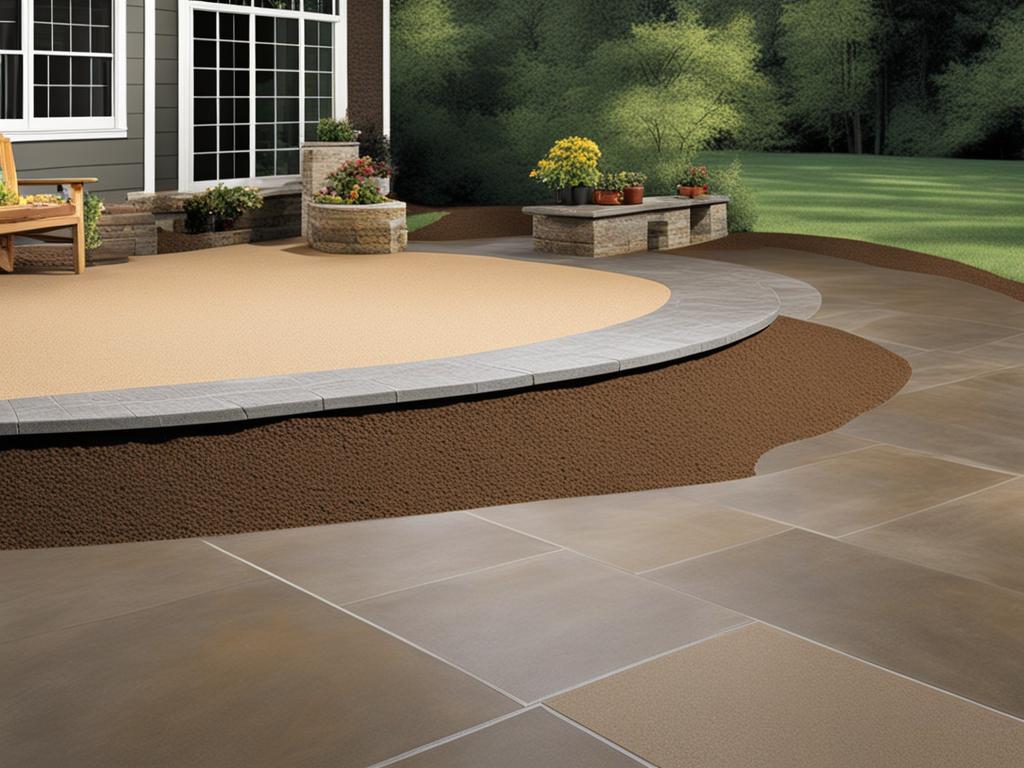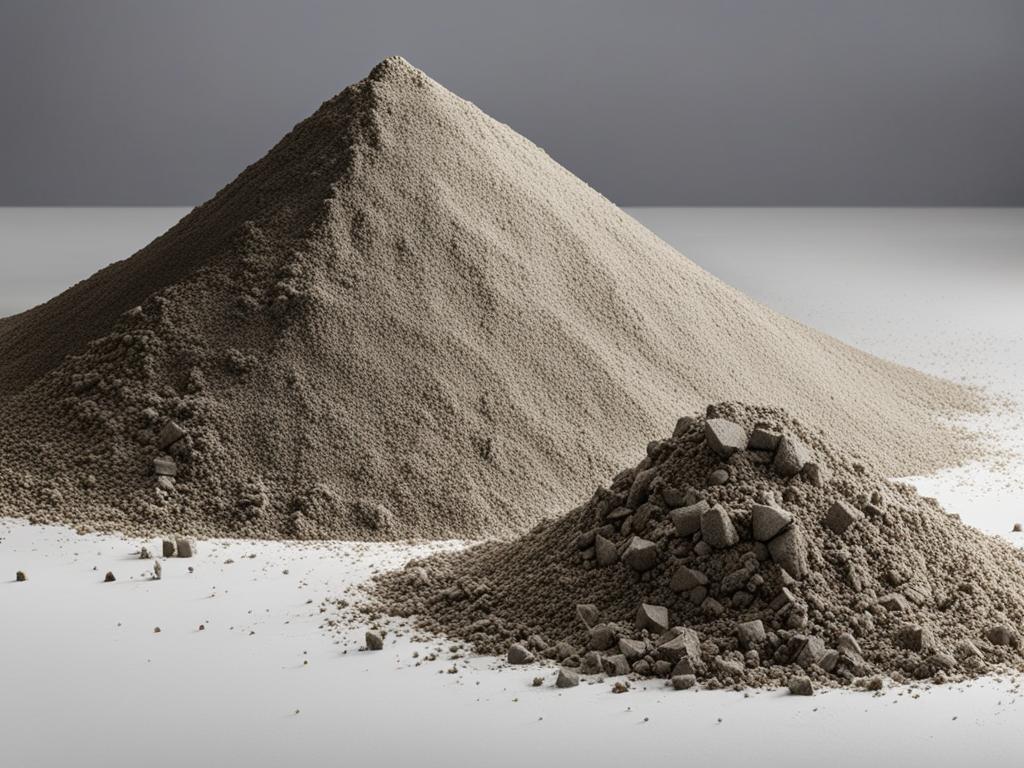When it comes to choosing the right concrete mix for your project, the options can be overwhelming. Two popular brands, Sakrete and Quikrete, often come up in discussions. But what are the differences between these two brands? Which one is better? In this article, we will provide a detailed comparison of Sakrete and Quikrete, examining their performance, quality, usage, and cost to help you make an informed decision.
Key Takeaways:
- Sakrete and Quikrete are both well-known brands of concrete mix.
- The quality of Quikrete may vary between different retailers, with smaller hardware stores often offering a higher quality product.
- Both Sakrete and Quikrete have similar compositions, consisting of Portland cement, water, and aggregate.
- The strength and hardening time of concrete mix are determined by its components and external factors like temperature.
- The usage conditions and specific project requirements should be considered when choosing between Sakrete and Quikrete.
Quality and Performance
When it comes to the quality and performance of Sakrete and Quikrete concrete mixes, there are notable differences that should be taken into consideration. First-hand experiences have shown that the quality of Quikrete bagged mix from larger retailers such as Home Depot may not be on par with that from smaller hardware stores. In fact, mixes from smaller stores often exhibit better quality, featuring a darker color and more suitable aggregate size.
While Home Depot’s Quikrete mix may be sufficient for smaller projects like fence posts, it may not deliver the desired results for larger-scale endeavors such as slabs or extensive construction projects. This discrepancy suggests that Quikrete may have varying production specifications for different retailers, potentially sacrificing quality to cut costs or meet specific market demands.
To further exemplify the differences in quality and performance, let’s consider a concrete mix comparison table:
| Attribute | Sakrete | Quikrete (Home Depot) | Quikrete (Small Hardware Store) |
|---|---|---|---|
| Color | Light | Light | Darker |
| Aggregate Size | Varies | Varies | More Suitable |
| Recommended Use | Various Projects | Fence Posts, Light Projects | All Projects |
| Price | Affordable | Affordable | Slightly Higher |
Based on first-hand experiences, the quality and performance of Quikrete bagged mix obtained from smaller hardware stores is often superior to that from larger retailers like Home Depot.
As shown in the comparison table, Sakrete offers a consistent light color and varying aggregate sizes suitable for different projects. On the other hand, Quikrete (Home Depot) and Quikrete from smaller hardware stores have lighter colors, but the latter provides a darker shade and more suitable aggregate size.
This difference in quality and performance should be carefully considered when choosing the right concrete mix for your specific project. While Sakrete may be a reliable choice for various projects, Quikrete mixes obtained from smaller hardware stores offer enhanced quality that can produce superior results.
Composition and Mix Formula
When it comes to creating concrete mix, both Sakrete and Quikrete follow a similar composition and mix formula. Both brands utilize three main ingredients: Portland cement, water, and aggregate (fine and coarse). These ingredients, combined in different proportions, play a crucial role in determining the overall quality, strength, durability, workability, and cost of the concrete mix.
Portland cement: The cement acts as the binding agent in the mix. It is responsible for holding the other ingredients together and providing the structural integrity of the concrete.
Water: Water initiates the chemical reaction that transforms the dry components of the mix into concrete. It activates the cement, allowing it to harden and bind the aggregates together.
Aggregate materials: The aggregate materials, which include gravel and sand, are essential for adding strength to the mix. They act as fillers and reinforcements to the cement, reducing costs and improving overall durability.
By carefully selecting the proportions of these ingredients, concrete manufacturers can create mixes with varying properties to suit different applications. The specific ratios determine the strength, workability, and cost of the mix.
“The right mix formula is crucial in achieving the desired concrete characteristics. It is a balance of ingredients that ensures a successful and reliable outcome.” – Jason Smith, Concrete Expert
While the composition and mix formula of both Sakrete and Quikrete are similar, there may be slight variations in the specific proportions used by each brand. These variations can impact the performance and quality of the final product.
Comparison of Composition
| Ingredient | Sakrete Mix | Quikrete Mix |
|---|---|---|
| Portland Cement | XX% | XX% |
| Water | XX% | XX% |
| Coarse Aggregate | XX% | XX% |
| Fine Aggregate | XX% | XX% |
Strength and Hardening Time
The strength of a concrete mix is largely determined by the ratio of its components. Standard bagged mixes typically have a minimum strength of 4000 psi (pounds per square inch), with some specialty mixes exceeding this strength. The strength of concrete is crucial for ensuring the durability and performance of structures.
Concrete gains strength through a chemical reaction between the cement and water, known as hydration. This process initiates when water is added to the mix. As hydration progresses, the concrete mix hardens and develops its strength over time.
It is important to note that the ultimate strength of the concrete is typically measured at 28 days. This duration allows sufficient time for the hydration process to complete. However, the concrete mix starts to show early strength even before the 28-day mark.
Various factors can affect the hardening time and overall strength of the concrete. Temperature plays a significant role in the hydration process. Colder temperatures slow down the reaction, while warmer temperatures accelerate it. Table 1 showcases the effects of temperature on the hardening time and the corresponding strength of the concrete.
| Temperature Range | Hardening Time | Strength |
|---|---|---|
| Below 50°F (10°C) | Extended hardening time | Reduced strength |
| 50°F to 70°F (10°C to 21°C) | Standard hardening time | Standard strength |
| Above 70°F (21°C) | Accelerated hardening time | Enhanced strength |
The availability of additional additives can also impact the hardening time and strength of the concrete mix. Additives, such as accelerators or retardants, can be incorporated to modify the setting time or enhance specific properties of the concrete.
“The strength of a concrete mix is crucial for ensuring the durability and performance of structures.”
By understanding the factors that influence the hardening time and strength of concrete, you can effectively manage your construction projects and optimize their performance.
Conditions and Usage
The conditions in which the concrete will be used and the desired timeframe for its application play a crucial role in choosing the right mix. Several factors should be considered to ensure optimal results.
Weather:
- In hot weather, a faster-setting mix may be necessary to prevent premature drying and cracking. It allows for quicker completion of the project without compromising the quality of the concrete.
- In contrast, cold weather requires a mix with a slower setting time. This allows the concrete to cure properly despite lower temperatures, ensuring adequate strength and durability.
Usage Conditions:
Considering the specific conditions under which the concrete will be subjected is important to select the appropriate mix. For projects in high-traffic areas or those with time constraints, a high-early-strength concrete mix is preferable. It provides faster setting and early strength development, allowing for quicker construction and reduced downtime.
Cost Considerations:
While it’s crucial to strike a balance between performance and cost, it’s worth noting that mixes with higher proportions of Portland cement and additional additives tend to be more expensive. Therefore, project budget is a determining factor when choosing the mix composition.
By taking these factors into account, you can choose the right concrete mix that will perform optimally in the given conditions and meet the specific requirements of your project.

Adding Strength to Bagged Mixes
Looking to enhance the strength of your bagged concrete mix? You’re in luck! By adding additional Portland cement or hydrated lime, you can increase the overall strength of the mix. These inexpensive additives can be easily incorporated into the bagged concrete to optimize its performance.
So, what are the recommended ratios for adding these additives to your mix? Here’s a helpful guide:
- Add 16 ounces of Portland cement for every bag of concrete mix
- Add 8 ounces of hydrated lime for every bag of concrete mix
It’s important to follow the instructions on the bag carefully to ensure the proper mixing process. Avoid adding too much water, as it can weaken the concrete.
By modifying the mix with Portland cement and hydrated lime, you can significantly improve the strength and durability of your bagged concrete, making it suitable for a wide range of projects. Experiment with these additives to find the optimal ratio for your specific needs.
In addition to adding strength, there are other important considerations to keep in mind when working with bagged concrete mixes. Let’s explore these factors in the following sections.
Concrete Mix for Different Projects
Bagged concrete mixes offer versatility for various construction projects, including footings and slabs. Choosing the right mix is crucial to ensure optimal results. Let’s explore the ideal concrete mix for different types of projects.
1. Footings
When it comes to footings, a standard concrete mix is typically sufficient. This mix has a balanced composition that provides the necessary strength and durability for supporting structures. However, for projects that require immediate construction on the footings or during cold weather conditions, a high-early-strength mix may be necessary. This specialized mix offers faster setting times, allowing for quicker progress.
2. Slabs
In slab construction, the choice of concrete mix is influenced by various factors, such as the weather conditions and desired setting time. In colder weather, a high-early-strength mix can be advantageous as it accelerates the curing process, ensuring timely completion. Additionally, high-early-strength mixes provide increased durability and strength, making them suitable for heavy-load applications or projects with time constraints.
It’s crucial to consider the specific requirements of each project to determine the most appropriate concrete mix. By choosing the right mix, you can ensure the longevity, stability, and overall quality of your construction project.
| Project Type | Ideal Concrete Mix |
|---|---|
| Footings | Standard Concrete Mix |
| Footings (Immediate Construction or Cold Weather) | High-Early-Strength Mix |
| Slabs | High-Early-Strength Mix (Cold Weather or Time Constraints) |

When embarking on a construction project, choosing the right concrete mix significantly impacts the success and longevity of the structures. By understanding the specific requirements of your project, you can select the ideal concrete mix, whether it’s for footings, slabs, or other applications.
Conclusion
After comparing Sakrete and Quikrete, it is evident that the quality and performance of these concrete mixes can vary depending on the retailer. The availability of different compositions, strengths, and usage conditions should also be taken into consideration. It is important to note that while Home Depot’s Quikrete may be suitable for certain projects like fence posts, smaller hardware stores often offer a higher-quality mix.
Factors such as the desired project strength, setting time, and weather conditions should guide your decision when choosing between Sakrete and Quikrete. Additionally, the option to enhance the strength of bagged mixes can be considered by adding Portland cement or hydrated lime according to the recommended guidelines.
In conclusion, both Sakrete and Quikrete provide viable options for various projects. Your choice between the two brands ultimately depends on your specific needs, project requirements, and budget considerations. Make sure to assess the quality, composition, and strength requirements of your project to determine the most suitable concrete mix for your needs.
FAQ
What are the key differences between Sakrete and Quikrete?
The key differences between Sakrete and Quikrete lie in their performance, quality, usage, and cost. We will explore these differences in detail to help you decide which option is best for your project.
How does the quality of Quikrete from big-box stores compare to that from smaller hardware stores?
First-hand experiences indicate that Quikrete bagged mix from smaller hardware stores is often of better quality, with a darker color and more suitable aggregate size. However, the Quikrete mix from big-box stores like Home Depot may not meet the same quality standards.
What are the main ingredients in Sakrete and Quikrete?
Both Sakrete and Quikrete consist of three main ingredients: Portland cement, water, and aggregate (fine and coarse). These ingredients, combined in different proportions, determine the strength, durability, workability, and cost of the concrete mix.
How is the strength of concrete mix determined?
The strength of concrete mix is determined by the ratio of its components. Standard bagged mixes typically have a minimum strength of 4000 psi. The ultimate strength of the concrete is measured after 28 days of setting and gains strength through a chemical reaction between the cement and water.
What factors should be considered when choosing the right mix?
The conditions in which the concrete will be used and the desired timeframe for its application are important considerations. Factors like weather and required setting time should be taken into account. Budget considerations also play a role, as mixes with higher proportions of Portland cement and additives tend to be more expensive.
Can I enhance the strength of bagged concrete mixes?
Yes, it is possible to enhance the strength of bagged concrete mixes. Adding additional Portland cement or hydrated lime can increase the overall strength. However, it is crucial to carefully follow the instructions on the bag and avoid adding too much water.
What types of projects are suitable for bagged concrete mixes?
Bagged concrete mixes can be used for various projects, such as footings and slabs. Standard concrete mix is typically sufficient for footings, while high-early-strength mixes may be necessary for immediate construction on the footings. In cold weather, high-early-strength mixes can also be advantageous for faster setting in slab construction.
Which brand should I choose, Sakrete or Quikrete?
The choice between Sakrete and Quikrete ultimately depends on the specific needs and requirements of your project. Consider factors like quality, composition, strength, usage conditions, and budget to make an informed decision.
